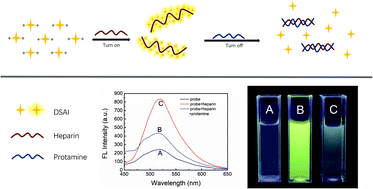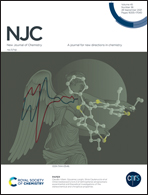A cationic on–off fluorescent sensor with AIE properties for heparin and protamine detection†
Abstract
In this research, a distyryl-anthracene derivative (DSAI) with two quaternary ammonium groups was synthesized. It emitted strong yellow-green fluorescence after aggregating with heparin through electrostatic attraction. In the presence of protamine, the fluorescence of DSAI remarkably quenched because of the greater affinity between heparin and protamine. Based on the change of fluorescence signal, a highly sensitive and selective method is successfully constructed to detect heparin and protamine. The DSAI sensor toward heparin showed a broad linear range (0.1 to 1.1 μg mL−1) and a low detection limit (down to 5.64 ng mL−1). The linear detection for protamine was in a wide range (0.1 to 1.7 μg mL−1) with the detection limit of 5.20 ng mL−1. Moreover, DSAI was successfully applied to detect heparin and protamine in complicated goat serum samples with satisfactory results. This simple and ultrasensitive biosensor has potential applications in diagnostics, therapeutics and biological research.



 Please wait while we load your content...
Please wait while we load your content...